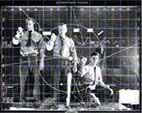
»Military Eyes&laqno;
Franz John
A Work in Progress in the Army Bunkers of the Golden Gate
From May-July 1996 , Franz John, a Berlin based artist, was Artist in Residence at the Headlands Center for the Arts. In this time he realised an art project with the former army bunkers around the Golden Gate of San Francisco.

The Headlands are a series of low coastal hills, cliffs, coves and beaches that form the northern edge of the entrance to the San Francisco Bay and are ten minutes north of San Francisco and the Golden Gate Bridge. Strategically this area has been used for military installations since the early 1800's and contain the remains of gun emplacements and forts that cover a full array of military activity during the 19th and 20th centuries - from Civil War gun batteries to Nike missile sites. To get an artistic access to this unusual architecture, Franz John was using the subject of "observation" to figure out if there is a certain relation between strategic planning, tactical behavior [SELECTION OF PLACE] and aesthetic perception.
Using the vantage points provided by the remains of the military bunkers, he was recording traces of soldiers' activities and observations made in the bunkers. To do this, Franz used both a camera obscura technique and a hand copier which he drew across the concrete surfaces. Carvings on the wall, sketches, notes and even accidental traces can give information about how generations of soldiers have lived and what they might have perceived. Those traces are also references of collective perception as the point of view throughout the bunkers was standardized by the restricted views from observation slits.
While I'm working, I think about the boredom of the soldiers who spent hour after hour in the bunkers doing tedious "militärfremde" jobs such as plotting wind direction, the humidity in the air and even the rotation of the earth. Camera obscura became a tool in art in the 15th century, I was completely surprised by the fact that the resulting images I get often look like a Renaissance painting.
Using special covers, the observation slits of the bunkers became the lens of the camera obscura. This way, the subject of "military point of view" was projected directly onto the concrete walls of the bunkers. This way lighttraces of moving objects such as ocean waves or passing ships appeared, forming a metareality on decaying surfaces, former military installations and graffitis.
This upside-down reality had, of course, a certain relation to Plato's Cave*. With a camera these temporary projections were »engraveded » on the photographic emulsion. To do this exposure times of several minutes to half an hour and more were necessary. These resulting images can also be seen as visual references of the "military brain".

(Holly Blake, Headlands Center for the Arts)
*In Plato's allegory, the limited view of the cave dweller substitutes shadow for the realities in light of day.